Divergent Trends of Open Surface Water Body Area of River and Lake Dominated Regions in the Yangtze River Basin from 1986 to 2022
Abstract
:1. Introduction
2. Materials and Methods
2.1. Study Region
2.2. Data
2.2.1. Landsat Imagery
2.2.2. Digital Elevation Model (DEM)
2.2.3. Lake Datasets
2.2.4. Dataset on Climate and Anthropogenic Factors
- Precipitation, Temperature and Evaporation: In order to explain the influence of climate factors on the change of water body area, this study selected the annual cumulative precipitation (PRE), annual average air temperature (TEM) and annual cumulative evaporation (EVP) as the important climate factors in the study areas of the YZRB. They are derived from The Daily Surface Climate Dataset for China (V3.0) (https://m.data.cma.cn/data/cdcdetail/dataCode/SURF_CLI_CHN_MUL_DAY_V3.0.html, accessed on 24 November 2024) to calculate annual meteorological data for each study area (Figures S2–S4). Missing values were imputed using random forest interpolation.
- NDVI: Vegetation changes can affect regional water area changes through direct or indirect pathways. The Normalized Difference Vegetation Index (NDVI) has been extensively used to detect vegetation growth and indicate change in vegetation cover [37]. The NDVI data utilized in this research are derived from the NOAA CDR AVHRR NDVI (Version 5) dataset with a spatial resolution of 0.05° × 0.05° and a temporal resolution of 1 day [38]. Annual NDVI is reconstructed by the maximum value composite (MVC) method, with the average value of all pixels within the corresponding region calculated to obtain the regional NDVI for the year (Figure S5).
- GDP: To explore the extent to which GDP changes influence the variations in the area of different water body in typical study regions, the annual GDP data were obtained from the China City Statistical Yearbook (https://data.cnki.net/yearBook/single?id=N2023070131, accessed on 24 November 2024) (Figure S6).
- Dams and Reservoirs: To explain the influence of dam and reservoir construction on open surface water, we utilized data extracted from the Global Reservoir and Dam Database (GRanD) v1.3 [30] and China-LDRL dataset (Version 3) [27] (Figure S7). Combined with high-resolution images on Google Earth Pro platform, the accuracy of the maximum extent of reservoirs within the study area was ensured through visual inspection and manual adjustment. The generated reservoir layer is superimposed with the obtained open surface water imagery to determine changes in reservoir water area. These changes were attributed to the increased water storage capacity of both new and existing reservoirs [39]. When evaluating the impact of reservoir on regional water body area, the reservoir area (RA) is excluded from the regional water surface calculation.
2.3. Methods
2.3.1. Enhancing Open Surface Water Extraction
2.3.2. Trend Detection of Open Surface Water Area
2.3.3. Attribution Analyses of Open Surface Water Area Change
3. Results
3.1. Accuracy Assessment of Annual Surface Water Maps
3.2. Trends in Open Surface Water of Typical Regions Across YZRB
3.3. Trends of Water Area Change in Lakes and Rivers in Typical Regions
3.4. Quantifying Driving Factors of Open Surface Water
4. Discussion
4.1. Water Body Expansion in Yangtze River Source Region by Climate Change
4.2. Increasing Open Surface Water in River-Dominated Regions by Impoundment of Reservoirs
4.3. Different Changing Trends in Lake Dominated Regions
4.4. Implication of Water Management in the YZRB and Limitations
4.4.1. Implications
4.4.2. Limitations
5. Conclusions
Supplementary Materials
Author Contributions
Funding
Data Availability Statement
Acknowledgments
Conflicts of Interest
References
- Bernacchi, C.J.; VanLoocke, A. Terrestrial Ecosystems in a Changing Environment: A Dominant Role for Water. Annu. Rev. Plant Biol. 2015, 66, 599–622. [Google Scholar] [CrossRef] [PubMed]
- Drenkhan, F.; Carey, M.; Huggel, C.; Seidel, J.; Oré, M.T. The changing water cycle: Climatic and socioeconomic drivers of water-related changes in the Andes of Peru. Wiley Interdiscip. Rev. Water 2015, 2, 715–733. [Google Scholar] [CrossRef]
- Zhang, W.; Zhu, Y.; Jiang, J. Effect of the Urbanization of Wetlands on Microclimate: A Case Study of Xixi Wetland, Hangzhou, China. Sustainability 2016, 8, 885. [Google Scholar] [CrossRef]
- Tariq, A.; Qin, S. Spatio-temporal variation in surface water in Punjab, Pakistan from 1985 to 2020 using machine-learning methods with time-series remote sensing data and driving factors. Agric. Water Manag. 2023, 280, 108228. [Google Scholar] [CrossRef]
- Ward, P.J.; de Ruiter, M.C.; Mård, J.; Schröter, K.; Van Loon, A.; Veldkamp, T.; von Uexkull, N.; Wanders, N.; AghaKouchak, A.; Arnbjerg-Nielsen, K.; et al. The need to integrate flood and drought disaster risk reduction strategies. Water Secur. 2020, 11, 100070. [Google Scholar] [CrossRef]
- Yu, F.; Chen, Z.; Ren, X.; Yang, G. Analysis of historical floods on the Yangtze River, China: Characteristics and explanations. Geomorphology 2009, 113, 210–216. [Google Scholar] [CrossRef]
- Gao, Y.; Chen, L.; Zhang, W.; Li, X.; Xu, Q. Spatiotemporal variations in characteristic discharge in the Yangtze River downstream of the Three Gorges Dam. Sci. Total Environ. 2021, 785, 147343. [Google Scholar] [CrossRef]
- Hao, H.; Dong, N.; Yang, M.; Wei, J.; Zhang, X.; Xu, S.; Yan, D.; Ren, L.; Leng, G.; Chen, L.; et al. The Changing Hydrology of an Irrigated and Dammed Yangtze River: Streamflow, Extremes, and Lake Hydrodynamics. Water Resour. Res. 2024, 60, e2024WR037841. [Google Scholar] [CrossRef]
- Li, X.; Ye, X.; Li, Z.; Zhang, D. Hydrological drought in two largest river-connecting lakes in the middle reaches of the Yangtze River, China. Hydrol. Res. 2023, 54, 82–98. [Google Scholar] [CrossRef]
- Yang, L.; Zhao, G.; Tian, P.; Mu, X.; Tian, X.; Feng, J.; Bai, Y. Runoff changes in the major river basins of China and their responses to potential driving forces. J. Hydrol. 2022, 607, 127536. [Google Scholar] [CrossRef]
- Zeng, F.; He, Q.; Li, Y.; Shi, W.; Yang, R.; Ma, M.; Huang, G.; Xiao, J.; Yang, X.; Di, D. Reduced Runoff in the Upper Yangtze River Due To Comparable Contribution of Anthropogenic and Climate Changes. Earth’s Future 2024, 12, e2023EF004028. [Google Scholar] [CrossRef]
- Xiao, Z.; Shi, P.; Jiang, P.; Hu, J.; Qu, S.; Chen, X.; Chen, Y.; Dai, Y.; Wang, J. The Spatiotemporal Variations of Runoff in the Yangtze River Basin under Climate Change. Adv. Meteorol. 2018, 2018, 5903451. [Google Scholar] [CrossRef]
- Deng, Y.; Jiang, W.; Tang, Z.; Ling, Z.; Wu, Z. Long-Term Changes of Open-Surface Water Bodies in the Yangtze River Basin Based on the Google Earth Engine Cloud Platform. Remote Sens. 2019, 11, 2213. [Google Scholar] [CrossRef]
- Yu, Z.; An, Q.; Liu, W.; Wang, Y. Analysis and evaluation of surface water changes in the lower reaches of the Yangtze River using Sentinel-1 imagery. J. Hydrol. Reg. Stud. 2022, 41, 101074. [Google Scholar] [CrossRef]
- Wang, Y.; Ma, J.; Xiao, X.; Wang, X.; Dai, S.; Zhao, B. Long-Term Dynamic of Poyang Lake Surface Water: A Mapping Work Based on the Google Earth Engine Cloud Platform. Remote Sens. 2019, 11, 313. [Google Scholar] [CrossRef]
- Zhu, J.; Song, C.; Wang, J.; Ke, L. China’s inland water dynamics: The significance of water body types. Proc. Natl. Acad. Sci. USA 2020, 117, 13876–13878. [Google Scholar] [CrossRef]
- Chawla, I.; Karthikeyan, L.; Mishra, A.K. A review of remote sensing applications for water security: Quantity, quality, and extremes. J. Hydrol. 2020, 585, 124826. [Google Scholar] [CrossRef]
- Ma, Y.; Wu, H.; Wang, L.; Huang, B.; Ranjan, R.; Zomaya, A.; Jie, W. Remote sensing big data computing: Challenges and opportunities. Future Gener. Comput. Syst. 2015, 51, 47–60. [Google Scholar] [CrossRef]
- Amani, M.; Ghorbanian, A.; Ahmadi, S.A.; Kakooei, M.; Moghimi, A.; Mirmazloumi, S.M.; Moghaddam, S.H.A.; Mahdavi, S.; Ghahremanloo, M.; Parsian, S.; et al. Google Earth Engine Cloud Computing Platform for Remote Sensing Big Data Applications: A Comprehensive Review. IEEE J. Sel. Top. Appl. Earth Obs. Remote Sens. 2020, 13, 5326–5350. [Google Scholar] [CrossRef]
- Gorelick, N.; Hancher, M.; Dixon, M.; Ilyushchenko, S.; Thau, D.; Moore, R. Google Earth Engine: Planetary-scale geospatial analysis for everyone. Remote Sens. Environ. 2017, 202, 18–27. [Google Scholar] [CrossRef]
- Feng, M.; Sexton, J.O.; Channan, S.; Townshend, J.R. A global, high-resolution (30-m) inland water body dataset for 2000: First results of a topographic–spectral classification algorithm. Int. J. Digit. Earth 2016, 9, 113–133. [Google Scholar] [CrossRef]
- Yamazaki, D.; Trigg, M.A.; Ikeshima, D. Development of a global ~ 90 m water body map using multi-temporal Landsat images. Remote Sens. Environ. 2015, 171, 337–351. [Google Scholar] [CrossRef]
- Pekel, J.-F.; Cottam, A.; Gorelick, N.; Belward, A.S. High-resolution mapping of global surface water and its long-term changes. Nature 2016, 540, 418–422. [Google Scholar] [CrossRef] [PubMed]
- Xing, W.; Guo, B.; Sheng, Y.; Yang, X.; Ji, M.; Xu, Y. Tracing surface water change from 1990 to 2020 in China’s Shandong Province using Landsat series images. Ecol. Indic. 2022, 140, 108993. [Google Scholar] [CrossRef]
- Paul, A.; Tripathi, D.; Dutta, D. Application and comparison of advanced supervised classifiers in extraction of water bodies from remote sensing images. Sustain. Water Resour. Manag. 2018, 4, 905–919. [Google Scholar] [CrossRef]
- Wang, W.; Teng, H.; Zhao, L.; Han, L. Long-Term Changes in Water Body Area Dynamic and Driving Factors in the Middle-Lower Yangtze Plain Based on Multi-Source Remote Sensing Data. Remote Sens. 2023, 15, 1816. [Google Scholar] [CrossRef]
- Zou, Z.; Dong, J.; Menarguez, M.A.; Xiao, X.; Qin, Y.; Doughty, R.B.; Hooker, K.V.; David Hambright, K. Continued decrease of open surface water body area in Oklahoma during 1984–2015. Sci. Total Environ. 2017, 595, 451–460. [Google Scholar] [CrossRef]
- Zhang, Y.; Du, J.; Guo, L.; Fang, S.; Zhang, J.; Sun, B.; Mao, J.; Sheng, Z.; Li, L. Long-term detection and spatiotemporal variation analysis of open-surface water bodies in the Yellow River Basin from 1986 to 2020. Sci. Total Environ. 2022, 845, 157152. [Google Scholar] [CrossRef]
- Chen, L.; Liu, Y.; Li, J.; Tian, P.; Zhang, H. Surface water changes in China’s Yangtze River Delta over the past forty years. Sustain. Cities Soc. 2023, 91, 104458. [Google Scholar] [CrossRef]
- Yang, X.; Lu, X. Drastic change in China’s lakes and reservoirs over the past decades. Sci. Rep. 2014, 4, 6041. [Google Scholar] [CrossRef]
- Jin, Z.; Azzari, G.; You, C.; Di Tommaso, S.; Aston, S.; Burke, M.; Lobell, D.B. Smallholder maize area and yield mapping at national scales with Google Earth Engine. Remote Sens. Environ. 2019, 228, 115–128. [Google Scholar] [CrossRef]
- Sun, Q.; Li, J. A method for extracting small water bodies based on DEM and remote sensing images. Sci. Rep. 2024, 14, 760. [Google Scholar] [CrossRef] [PubMed]
- Foga, S.; Scaramuzza, P.L.; Guo, S.; Zhu, Z.; Dilley, R.D.; Beckmann, T.; Schmidt, G.L.; Dwyer, J.L.; Joseph Hughes, M.; Laue, B. Cloud detection algorithm comparison and validation for operational Landsat data products. Remote Sens. Environ. 2017, 194, 379–390. [Google Scholar] [CrossRef]
- NASA JPL. NASADEM Merged DEM Global 1 Arc Second V001 [Data Set]. NASA EOSDIS Land Processes Distributed Active Archive Center 2020. Available online: https://lpdaac.usgs.gov/products/nasadem_hgtv001/ (accessed on 24 November 2024).
- Messager, M.L.; Lehner, B.; Grill, G.; Nedeva, I.; Schmitt, O. Estimating the volume and age of water stored in global lakes using a geo-statistical approach. Nat. Commun. 2016, 7, 13603. [Google Scholar] [CrossRef] [PubMed]
- Wang, X.; Xiao, X.; Qin, Y.; Dong, J.; Wu, J.; Li, B. Improved maps of surface water bodies, large dams, reservoirs, and lakes in China. Earth Syst. Sci. Data 2022, 14, 3757–3771. [Google Scholar] [CrossRef]
- Cong, N.; Piao, S.; Chen, A.; Wang, X.; Lin, X.; Chen, S.; Han, S.; Zhou, G.; Zhang, X. Spring vegetation green-up date in China inferred from SPOT NDVI data: A multiple model analysis. Agric. For. Meteorol. 2012, 165, 104–113. [Google Scholar] [CrossRef]
- Vermote, E.; Justice, C.; Csiszar, I.; Eidenshink, J.; Myneni, R.; Baret, F.; Masuoka, E.; Wolfe, R.; Claverie, M.; NOAA CDR Program. NOAA Climate Data Record (CDR) of Normalized Difference Vegetation Index (NDVI), Version 4; NOAA National Centers for Environmental Information: Boulder, CO, USA, 2014. [Google Scholar] [CrossRef]
- Zeng, Y.; Yang, X.; Fang, N.; Shi, Z. Large-scale afforestation significantly increases permanent surface water in China’s vegetation restoration regions. Agric. For. Meteorol. 2020, 290, 108001. [Google Scholar] [CrossRef]
- Das, S.; Banerjee, S. Investigation of changes in seasonal streamflow and sediment load in the Subarnarekha-Burhabalang basins using Mann-Kendall and Pettitt tests. Arab. J. Geosci. 2021, 14, 946. [Google Scholar] [CrossRef]
- Yang, Y.; Sun, H.; Zhu, M.; Wang, J.; Zhang, W. An R package of maximum entropy production model to estimate 41 years of global evapotranspiration. J. Hydrol. 2022, 614, 128639. [Google Scholar] [CrossRef]
- Nie, B.; Du, Y.; Du, J.; Rao, Y.; Zhang, Y.; Zheng, X.; Ye, N.; Jin, H. A novel regression method: Partial least distance square regression methodology. Chemom. Intell. Lab. Syst. 2023, 237, 104827. [Google Scholar] [CrossRef]
- Shi, Z.H.; Ai, L.; Li, X.; Huang, X.D.; Wu, G.L.; Liao, W. Partial least-squares regression for linking land-cover patterns to soil erosion and sediment yield in watersheds. J. Hydrol. 2013, 498, 165–176. [Google Scholar] [CrossRef]
- Zhang, F.; Shi, X.; Zeng, C.; Wang, L.; Xiao, X.; Wang, G.; Chen, Y.; Zhang, H.; Lu, X.; Immerzeel, W. Recent stepwise sediment flux increase with climate change in the Tuotuo River in the central Tibetan Plateau. Sci. Bull. 2020, 65, 410–418. [Google Scholar] [CrossRef]
- Ji, P.; Yuan, X.; Ma, F.; Pan, M. Accelerated hydrological cycle over the Sanjiangyuan region induces more streamflow extremes at different global warming levels. Hydrol. Earth Syst. Sci. 2020, 24, 5439–5451. [Google Scholar] [CrossRef]
- Fensholt, R.; Langanke, T.; Rasmussen, K.; Reenberg, A.; Prince, S.D.; Tucker, C.; Scholes, R.J.; Le, Q.B.; Bondeau, A.; Eastman, R.; et al. Greenness in semi-arid areas across the globe 1981–2007—An Earth Observing Satellite based analysis of trends and drivers. Remote Sens. Environ. 2012, 121, 144–158. [Google Scholar] [CrossRef]
- Wang, D.; Wang, G.; Anagnostou, E.N. Evaluation of canopy interception schemes in land surface models. J. Hydrol. 2007, 347, 308–318. [Google Scholar] [CrossRef]
- Swann, A.L.S.; Fung, I.Y.; Chiang, J.C.H. Mid-latitude afforestation shifts general circulation and tropical precipitation. Proc. Natl. Acad. Sci. USA 2012, 109, 712–716. [Google Scholar] [CrossRef]
- Liang, H.; Zhang, D.; Wang, W.; Yu, S.; Nimai, S. Evaluating future water security in the upper Yangtze River Basin under a changing environment. Sci. Total Environ. 2023, 889, 164101. [Google Scholar] [CrossRef]
- Yang, X.; Lu, X.; Ran, L.; Tarolli, P. Geomorphometric Assessment of the Impacts of Dam Construction on River Disconnectivity and Flow Regulation in the Yangtze Basin. Sustainability 2019, 11, 3427. [Google Scholar] [CrossRef]
- Liu, B.; Zhou, Y.; Cui, Y.; Dong, J.; Wang, X.; Zhang, Q.; Zou, Z.; Xiao, X. Exacerbating water shortage induced by continuous expansion of surface artificial water bodies in the Yellow River Basin. J. Hydrol. 2024, 633, 130979. [Google Scholar] [CrossRef]
- Guo, S.; Xiong, L.; Zha, X.; Zeng, L.; Cheng, L. Impacts of the Three Gorges Dam on the streamflow fluctuations in the downstream region. J. Hydrol. 2021, 598, 126480. [Google Scholar] [CrossRef]
- Peng, Y.; He, G.; Wang, G.; Cao, H. Surface Water Changes in Dongting Lake from 1975 to 2019 Based on Multisource Remote-Sensing Images. Remote Sens. 2021, 13, 1827. [Google Scholar] [CrossRef]
- Cai, X.; Feng, L.; Wang, Y.; Chen, X. Influence of the Three Gorges Project on the Water Resource Components of Poyang Lake Watershed: Observations from TRMM and GRACE. Adv. Meteorol. 2015, 2015, 148913. [Google Scholar] [CrossRef]
- Guo, R.; Zhu, Y.; Liu, Y. A Comparison Study of Precipitation in the Poyang and the Dongting Lake Basins from 1960–2015. Sci. Rep. 2020, 10, 3381. [Google Scholar] [CrossRef] [PubMed]
- Zhang, Q.; Li, L.; Wang, Y.-G.; Werner, A.D.; Xin, P.; Jiang, T.; Barry, D.A. Has the Three-Gorges Dam made the Poyang Lake wetlands wetter and drier? Geophys. Res. Lett. 2012, 39, L20402. [Google Scholar] [CrossRef]
- Feng, L.; Han, X.; Hu, C.; Chen, X. Four decades of wetland changes of the largest freshwater lake in China: Possible linkage to the Three Gorges Dam? Remote Sens. Environ. 2016, 176, 43–55. [Google Scholar] [CrossRef]
- Peng, H.; Xia, H.; Shi, Q.; Tang, Z.; Chen, H. Monitoring of wetland cover changes in protected areas to trade-offs between ecological conservation and food security: A case study from the Dongting Lake, China. Ecol. Inform. 2023, 78, 102338. [Google Scholar] [CrossRef]
- Wei, X.; Khachatryan, H.; Zhu, H. Poyang lake wetlands restoration in China: An analysis of farmers’ perceptions and willingness to participate. J. Clean. Prod. 2021, 284, 125001. [Google Scholar] [CrossRef]
- Wang, Y.-W.; Pendlebury, J.; Nolf, C. The water heritage of China: The polders of Tai Lake Basin as continuing landscape. Plan. Perspect. 2023, 38, 949–974. [Google Scholar] [CrossRef]
- Guo, Z.; Zhao, Q.; Shi, X. A long-term (1984–2021) wetland classification dataset for the Yangtze River Basin from continuous Landsat image collections. Total Environ. Adv. 2024, 11, 200111. [Google Scholar] [CrossRef]
- Mao, D.; Wang, Z.; Wu, J.; Wu, B.; Zeng, Y.; Song, K.; Yi, K.; Luo, L. China’s wetlands loss to urban expansion. Land Degrad. Dev. 2018, 29, 2644–2657. [Google Scholar] [CrossRef]
- Xu, X.; Liu, J.; Tan, Y.; Yang, G. Quantifying and optimizing agroecosystem services in China’s Taihu Lake Basin. J. Environ. Manag. 2021, 277, 111440. [Google Scholar] [CrossRef] [PubMed]
- Tao, Y.; Li, Z.; Sun, X.; Qiu, J.; Pueppke, S.G.; Ou, W.; Guo, J.; Tao, Q.; Wang, F. Supply and demand dynamics of hydrologic ecosystem services in the rapidly urbanizing Taihu Lake Basin of China. Appl. Geogr. 2023, 151, 102853. [Google Scholar] [CrossRef]
- Li, B.; Chen, N.; Wang, W.; Wang, C.; Schmitt, R.J.P.; Lin, A.; Daily, G.C. Eco-environmental impacts of dams in the Yangtze River Basin, China. Sci. Total Environ. 2021, 774, 145743. [Google Scholar] [CrossRef] [PubMed]
- Zhou, J.; Zhou, X.; Du, X.; Wang, F. Research on design of dam-break risks control for cascade reservoirs. Shuili Fadian Xuebao/J. Hydroelectr. Eng. 2018, 37, 1–10. [Google Scholar] [CrossRef]
- Lin, J.; Ding, W.; Zhou, H.; Wang, H. Mitigating adverse impacts of reservoir impoundment on lake ecology: A case study of the Three Gorges Reservoir and Dongting Lake. J. Clean. Prod. 2024, 451, 141835. [Google Scholar] [CrossRef]
- Wu, Q.; Lane, C.R.; Li, X.; Zhao, K.; Zhou, Y.; Clinton, N.; DeVries, B.; Golden, H.E.; Lang, M.W. Integrating LiDAR data and multi-temporal aerial imagery to map wetland inundation dynamics using Google Earth Engine. Remote Sens. Environ. 2019, 228, 1–13. [Google Scholar] [CrossRef]
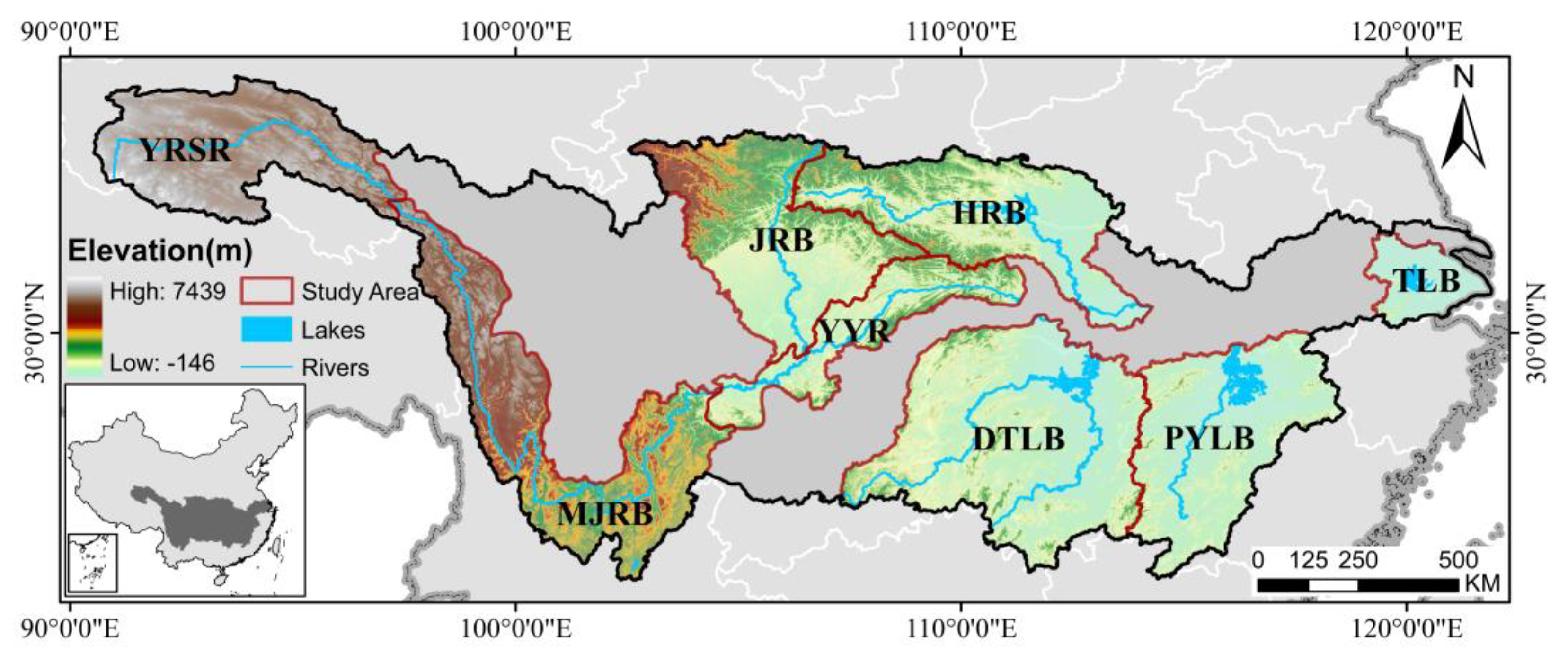
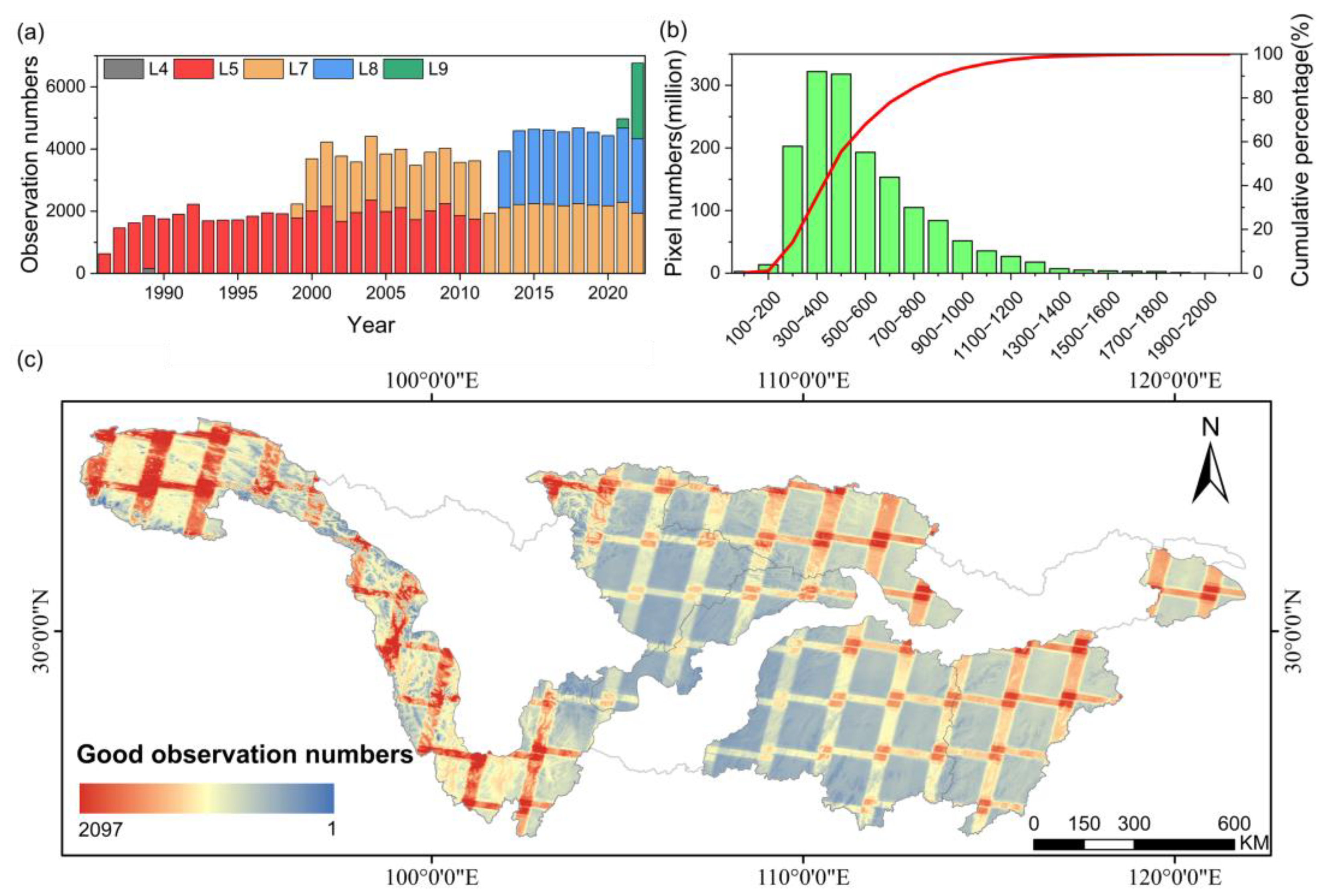
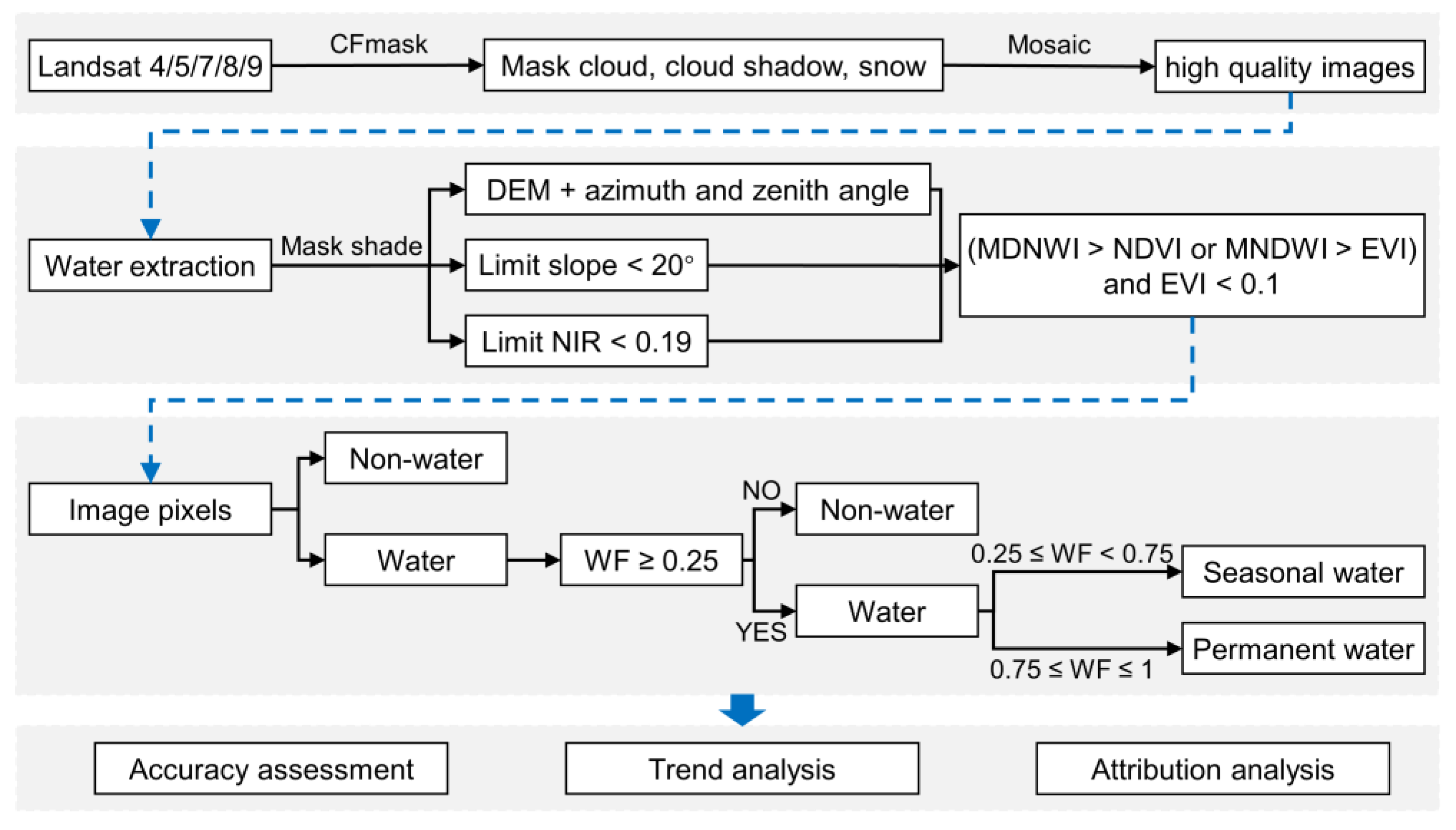
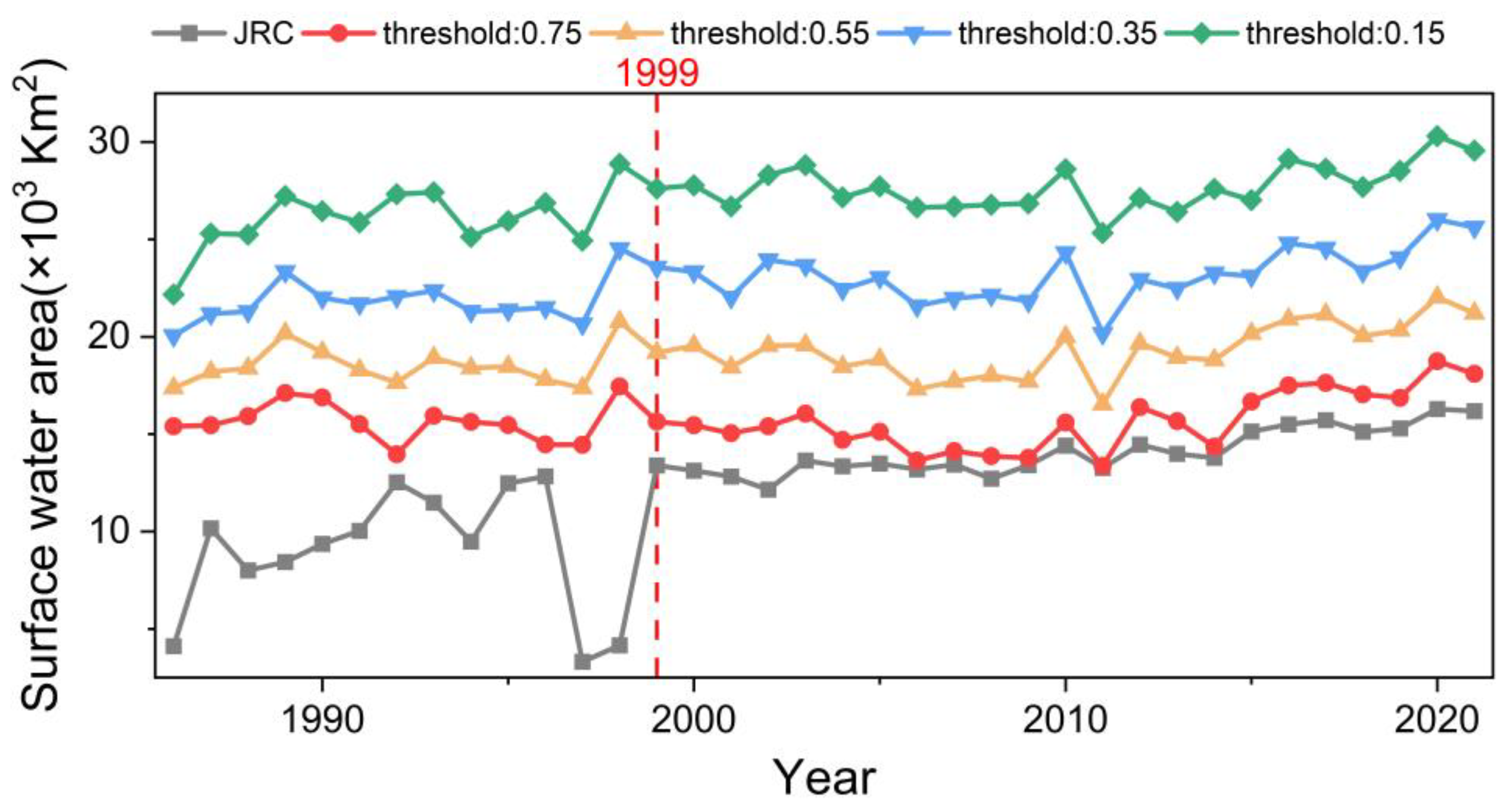
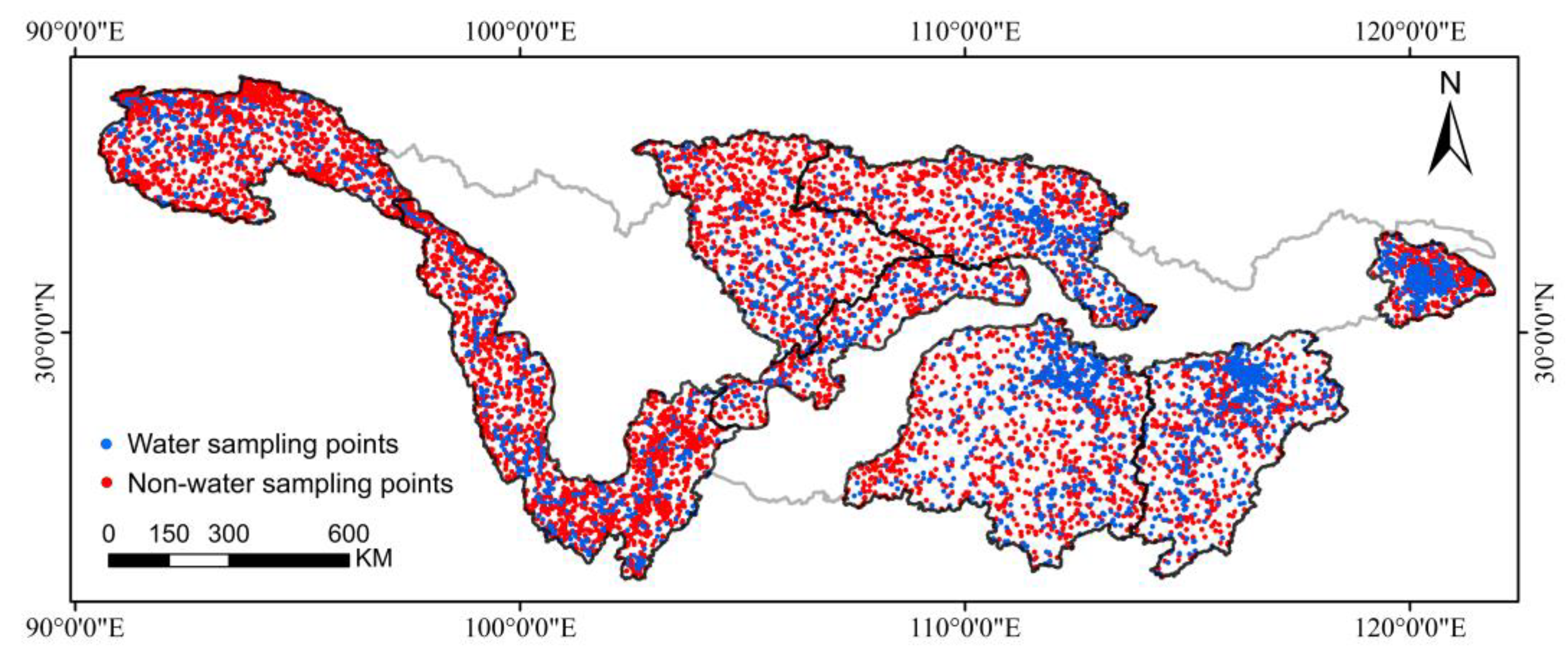
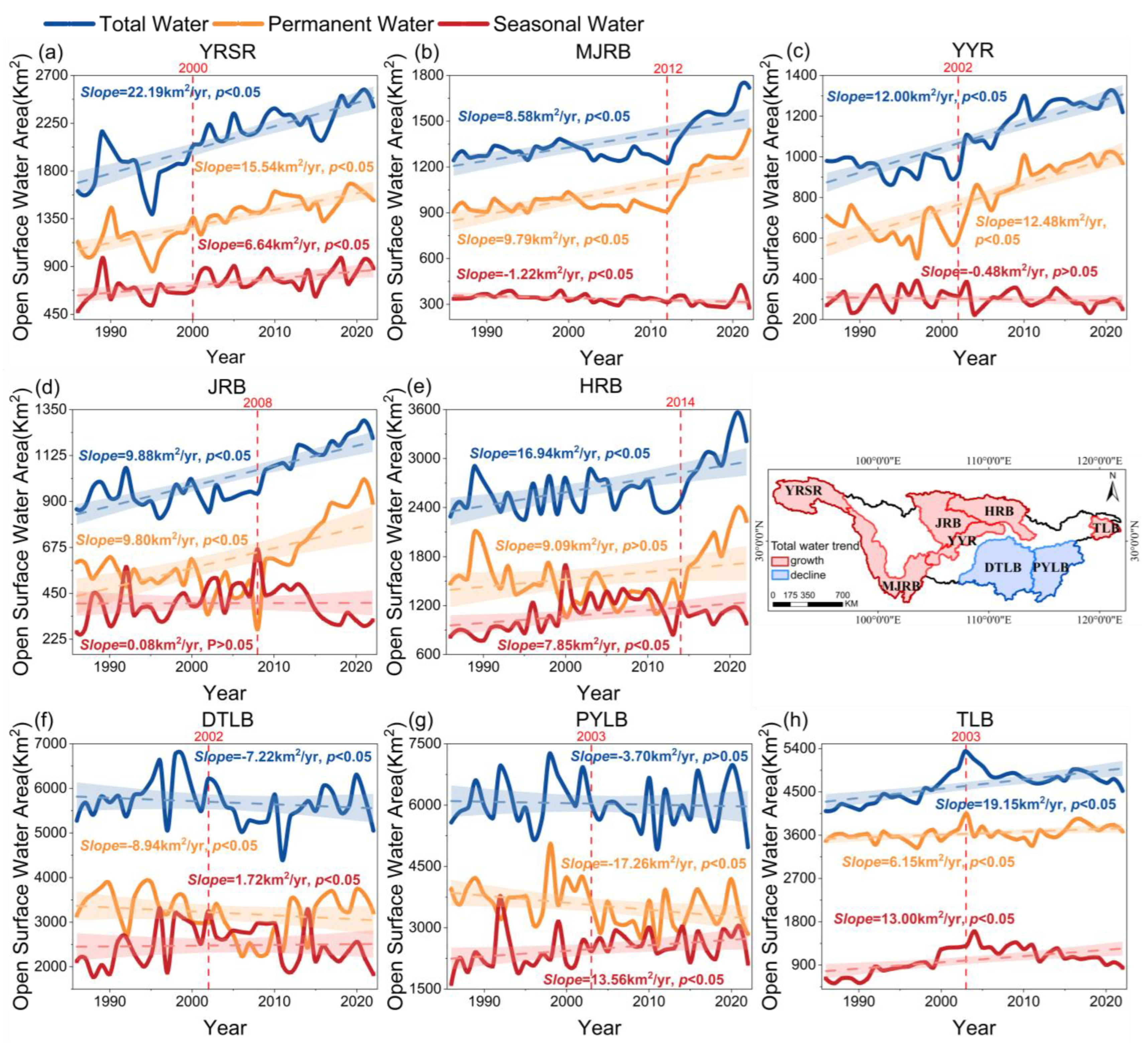
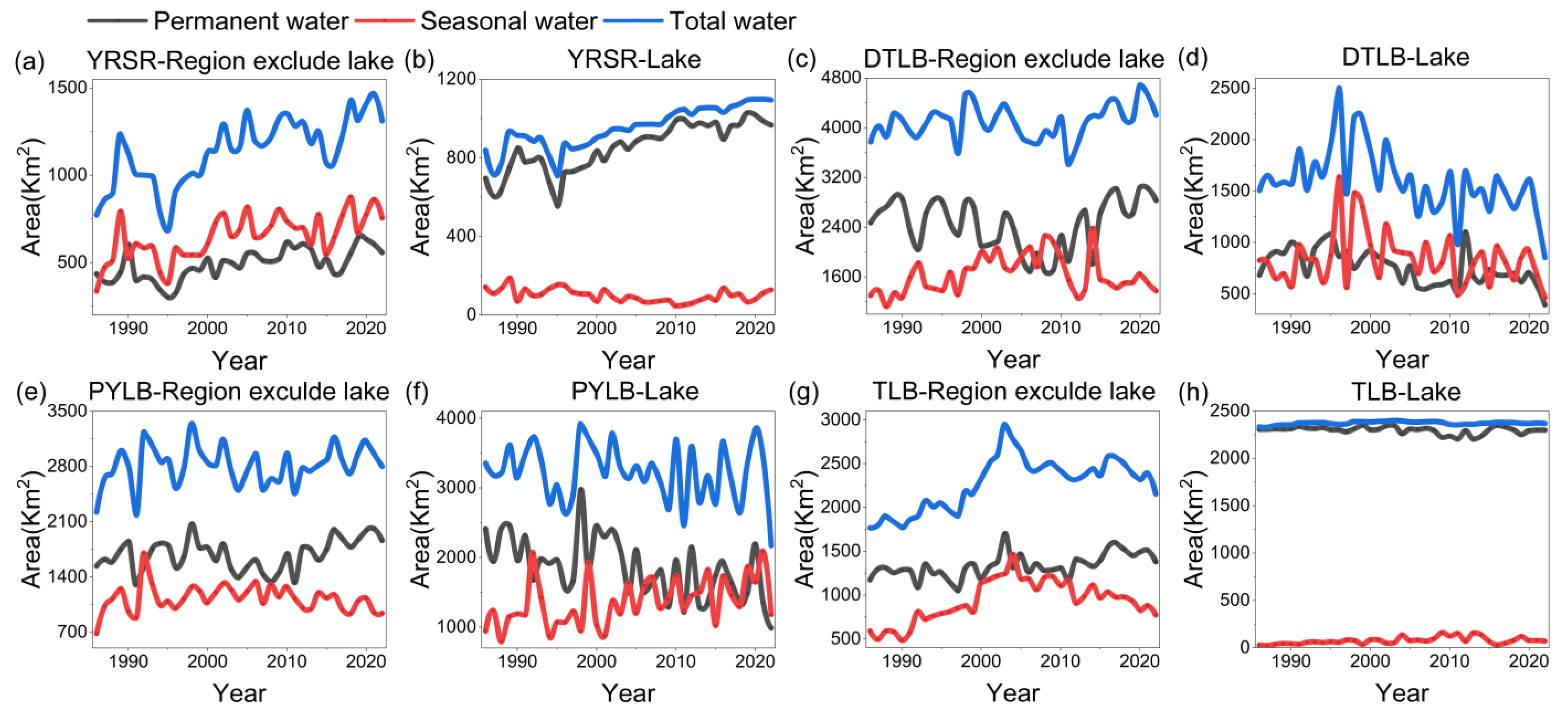

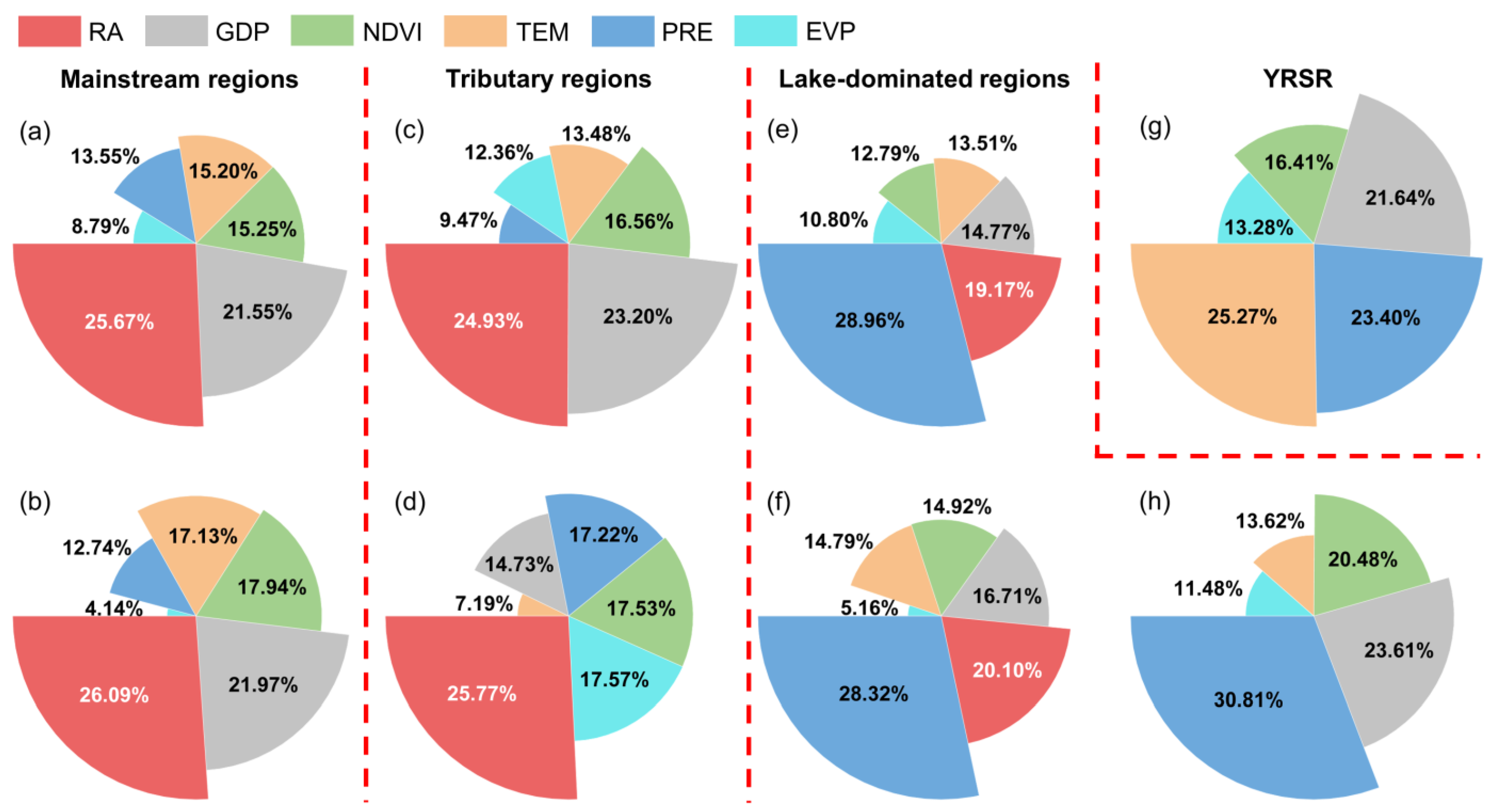
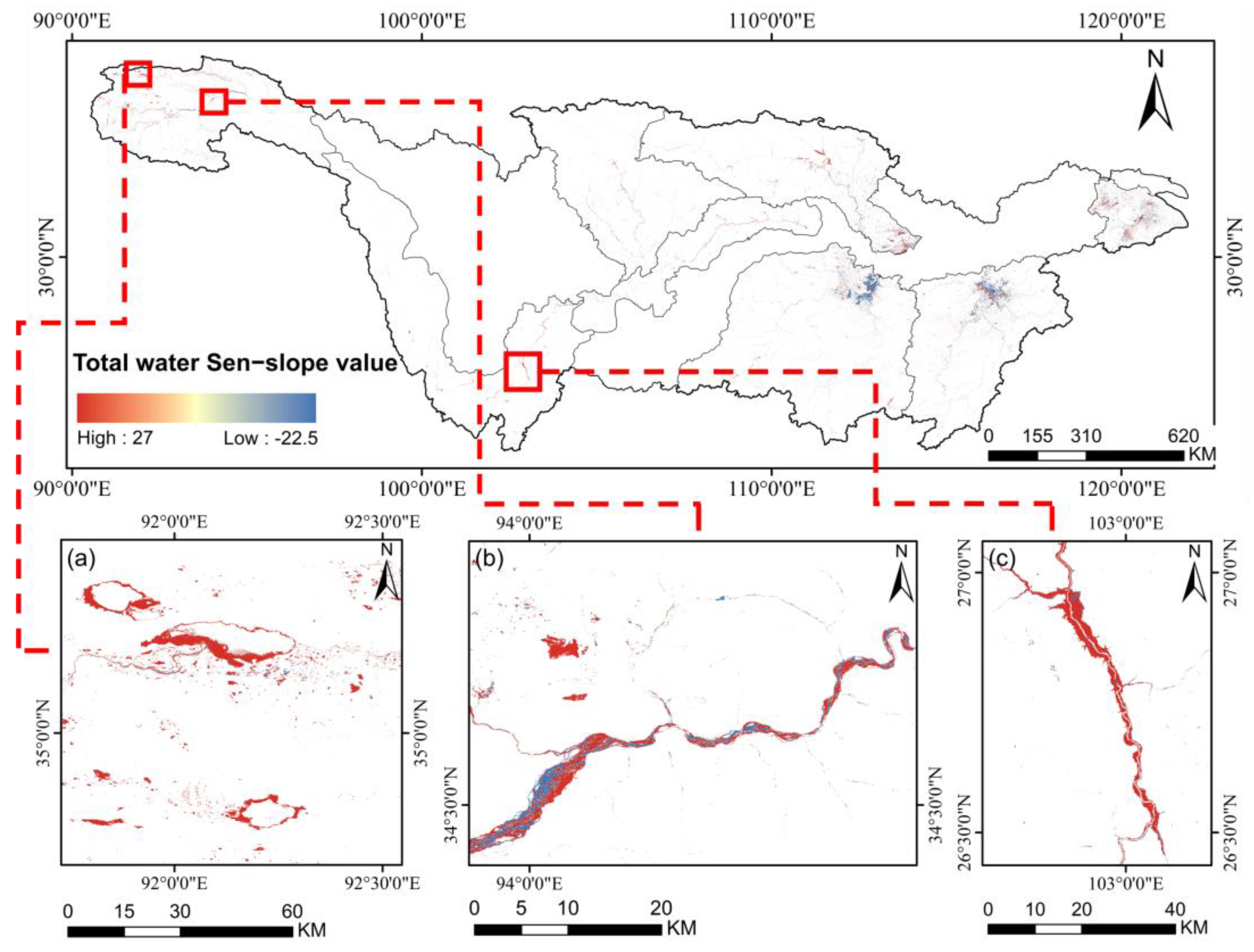
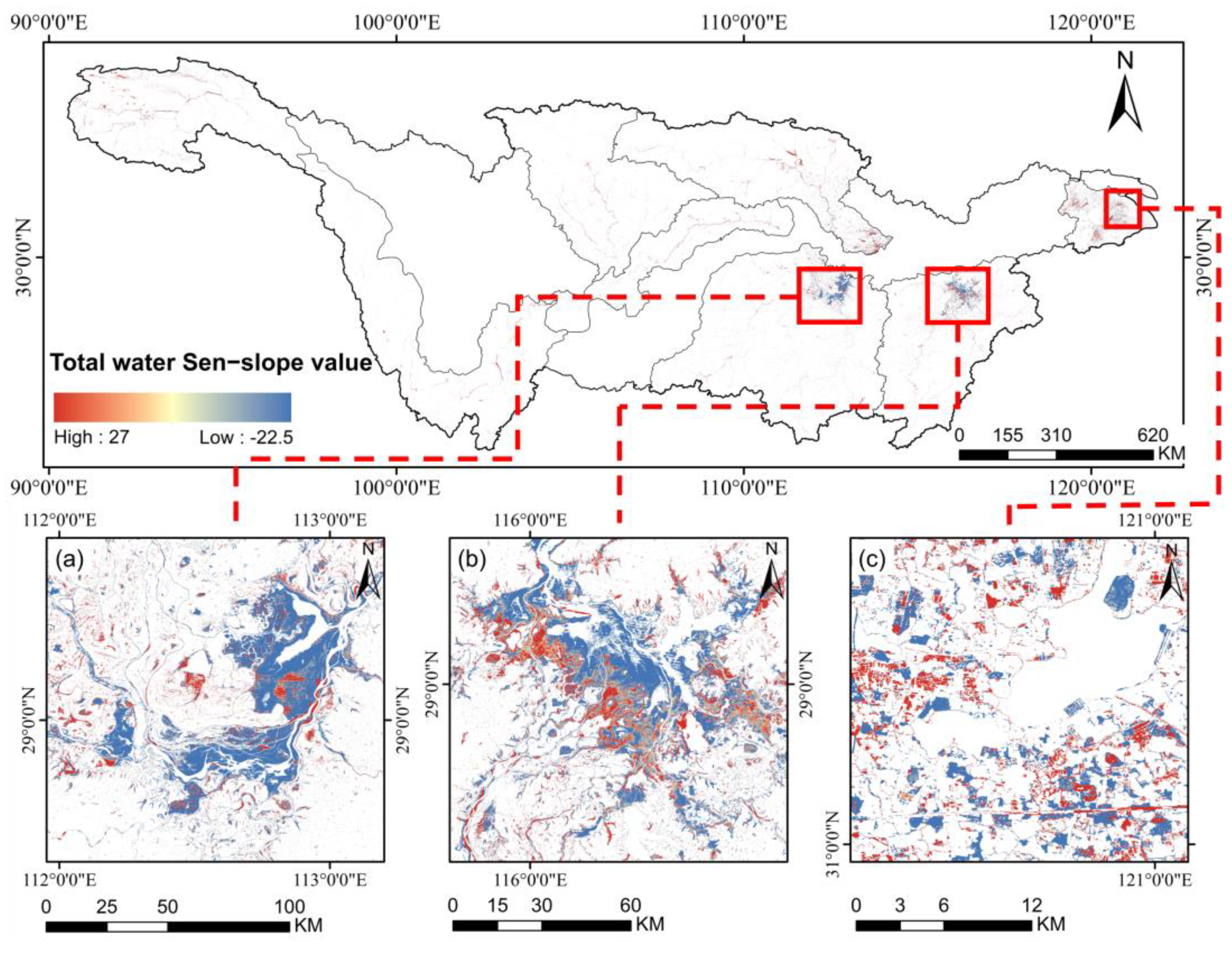
| 1990 | Classification | Total | UA 2 (%) | |
| Water | Non-water | |||
| Water | 2302 | 104 | 2406 | 95.68 |
| Non-water | 206 | 6891 | 7097 | 97.10 |
| Total | 2508 | 6995 | 9503 | OA 3 = 96.74% |
| PA1 (%) | 91.79 | 98.51 | — | KC 4 = 0.91 |
| 2000 | Classification | Total | UA (%) | |
| Water | Non-water | |||
| Water | 1767 | 157 | 1924 | 91.84 |
| Non-water | 142 | 6839 | 6981 | 97.97 |
| Total | 1909 | 6996 | 8905 | OA = 96.64% |
| PA (%) | 92.56 | 97.76 | — | KC = 0.90 |
| 2010 | Classification | Total | UA (%) | |
| Water | Non-water | |||
| Water | 2165 | 127 | 2292 | 94.46 |
| Non-water | 177 | 6870 | 7047 | 97.49 |
| Total | 2342 | 6997 | 9339 | OA = 96.74% |
| PA (%) | 92.44 | 98.18 | — | KC = 0.91 |
| 2020 | Classification | Total | UA (%) | |
| Water | Non-water | |||
| Water | 2086 | 138 | 2224 | 93.79 |
| Non-water | 170 | 6865 | 7035 | 97.58 |
| Total | 2256 | 7003 | 9259 | OA = 96.67% |
| PA (%) | 92.46 | 98.03 | — | KC = 0.91 |
Disclaimer/Publisher’s Note: The statements, opinions and data contained in all publications are solely those of the individual author(s) and contributor(s) and not of MDPI and/or the editor(s). MDPI and/or the editor(s) disclaim responsibility for any injury to people or property resulting from any ideas, methods, instructions or products referred to in the content. |
© 2025 by the authors. Licensee MDPI, Basel, Switzerland. This article is an open access article distributed under the terms and conditions of the Creative Commons Attribution (CC BY) license (https://creativecommons.org/licenses/by/4.0/).
Share and Cite
Zhao, Y.; Liu, H.; Du, J.; Guo, C.; Xiao, L.; Yi, Y. Divergent Trends of Open Surface Water Body Area of River and Lake Dominated Regions in the Yangtze River Basin from 1986 to 2022. Remote Sens. 2025, 17, 1008. https://doi.org/10.3390/rs17061008
Zhao Y, Liu H, Du J, Guo C, Xiao L, Yi Y. Divergent Trends of Open Surface Water Body Area of River and Lake Dominated Regions in the Yangtze River Basin from 1986 to 2022. Remote Sensing. 2025; 17(6):1008. https://doi.org/10.3390/rs17061008
Chicago/Turabian StyleZhao, Yunxuan, Hongxi Liu, Jizeng Du, Chao Guo, Leling Xiao, and Yujun Yi. 2025. "Divergent Trends of Open Surface Water Body Area of River and Lake Dominated Regions in the Yangtze River Basin from 1986 to 2022" Remote Sensing 17, no. 6: 1008. https://doi.org/10.3390/rs17061008
APA StyleZhao, Y., Liu, H., Du, J., Guo, C., Xiao, L., & Yi, Y. (2025). Divergent Trends of Open Surface Water Body Area of River and Lake Dominated Regions in the Yangtze River Basin from 1986 to 2022. Remote Sensing, 17(6), 1008. https://doi.org/10.3390/rs17061008








